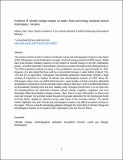| dc.description.abstract | This review presents research evidence of climate change and anthropogenic impacts on the slopes of Mt. Kilimanjaro and its implications on water, food and energy production (WFE nexus). While there exist divided scholarly opinions on the impacts of climate change on the Mt. Kilimanjaro glacier, consistent decreases in precipitation amounts are evident throughout the existing literature. The 2050 projections indicate increases in the precipitation amounts by approximately 16–18%. However, it is also stated that there will be a concomitant increase in water deficit of about 71%, 27% and 1% in agriculture, hydropower and livestock production respectively. Despite a large number of researches on impacts of climate and anthropogenic pressure on WFE along Mt. Kilimanjaro slopes, there are still limited long-term, good-quality and high-resolution altitudinal precipitation, temperature records and observation network. Moreover, there is limited information on groundwater recharge areas and their stability under changing environment. It is not clear how the interdependence and interaction between climate change, irrigation, vegetation and river discharges affect groundwater recharge process. Also, there is scarce information on future land use/cover changes. Very limited studies focused on fog water deposition for Mt. Kilimanjaro forest and East Africa, despite its relevance as the water tower of the mountain streams. The review further highlights how both climate and anthropogenic impacts may affect ecosystem services in the region. There is a need for developing adaptive strategies for responding to climate change and anthropogenic impacts on the slopes of Mt. Kilimanjaro now and into the future. | en_US |

